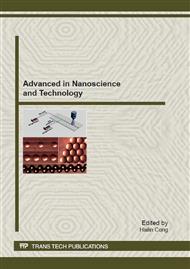p.72
p.76
p.80
p.86
p.91
p.95
p.101
p.108
p.112
Electrochromic Properties of the Multicolored Polyaniline Nanofilms
Abstract:
In this paper, electrochemical polymerization method was used to prepare electrochromic PANI films with different thicknesses via changing the polymerization time. It is found that the obtained PANI films are uniform and have good adherence with the ITO bases. Scanning electron microscope (SEM) images further show that the obtained films exhibited the tremella like lamellar structures with the diameter of each leaf about 100nm and the thickness of about 20nm at polymerization time of 8min. Optical electronic tests indicated that the films showed a gradient color variation from pale yellow, light yellow to green, blue-green, blue and dark blue among -0.2V and 1.0V. Furthermore, the color saturation increased and the hues became more abundant as polymerization time extended. The optical contrast ratios (ΔT) firstly increased to the maximum of 35% and then decreased, while the response time became longer. The results illustrate that the different shades of color are probably obtained through electrochemical polymerization method, which is important for the preparation of RGB full color system.
Info:
Periodical:
Pages:
91-94
Citation:
Online since:
February 2012
Authors:
Keywords:
Price:
Сopyright:
© 2012 Trans Tech Publications Ltd. All Rights Reserved
Share:
Citation:


